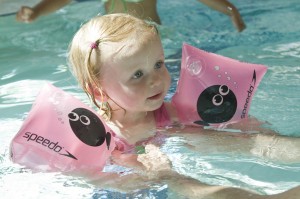It can be an anxious task with the mere thought on how to safely introduce your baby/toddler to a swimming pool. But it’s not as hard as you think if you know the right and safe way to let your toddler learn to swim.
Warning: A baby should be over 6 months old, due to their bodies being developed enough to regulate at that age, and they will have better head co-ordination.
The benefits of introducing your baby/toddler to a swimming pool.
- The stimulating effect of swimming can help with higher intelligence, concentration, perceptual abilities, and alertness.
- Keeps your child fit by working all their muscles.
- Babies can be very relaxed and peaceful in the water, giving them feelings of wellbeing and confidence.
Introducing your baby/toddler to the swimming pool for the first time:
One important factor is to always remember this is your toddlers first experience of being inside a swimming pool, the water will confuse their balance (especially when their body is getting used too/or just got used to walking) so slowly and patience is the key.
When going into the water (start in the shallow where you are confident in balancing on the floor) you can either you can go in first and wait for them from a small distance to explore their way in (being face to face), or you can carry them in a horizontal position (often known as the heart to heart position).
Hint:
- For their first experience you should take particular care in them being comfortable and happy, hold them at all times and do not let go. Any bad experience or trauma for the first time may prove more difficult for them to try again, if they associate it with bad experience.
- Go very slow and gentle, and at their pace. If they find a particular situation too distressing, then stop and go back to their comfort level, and slowly reintroduce the next step again.
Holding methods:
- Make sure you are facing their level, you can achieve this by crouching in the water, and having your shoulders under water level – with slight adjustment according to your height you should be both on the same eye level.
- If you hold them by their arm pits (whilst still facing them), this will allow them to get the feel of the water motion and enable them to adjust to it.
- If the child is older then you should try the ‘tow technique’ which is where you pull your child along by holding their hands and walking backwards in front of them. The water will keep their body afloat and horizontal as you pull your child along.
Making it fun:
Remember they are children and young, and they’ll be stimulated by fun! Using swimming pool toys and floats will achieve this. Also, the majority of local swimming pools can offer specific time slots set for babies and toddlers – which can feature big inflatable floats, slides, and even group sessions. (Sharing the experience with other parents is an ideal way to support each other whilst trying to achieve the same goals, and you won’t need to suffer in silence if you can’t get something right). It is always a good idea to research what your local swimming pools offer via their websites or pamphlets.
Additional resources:

